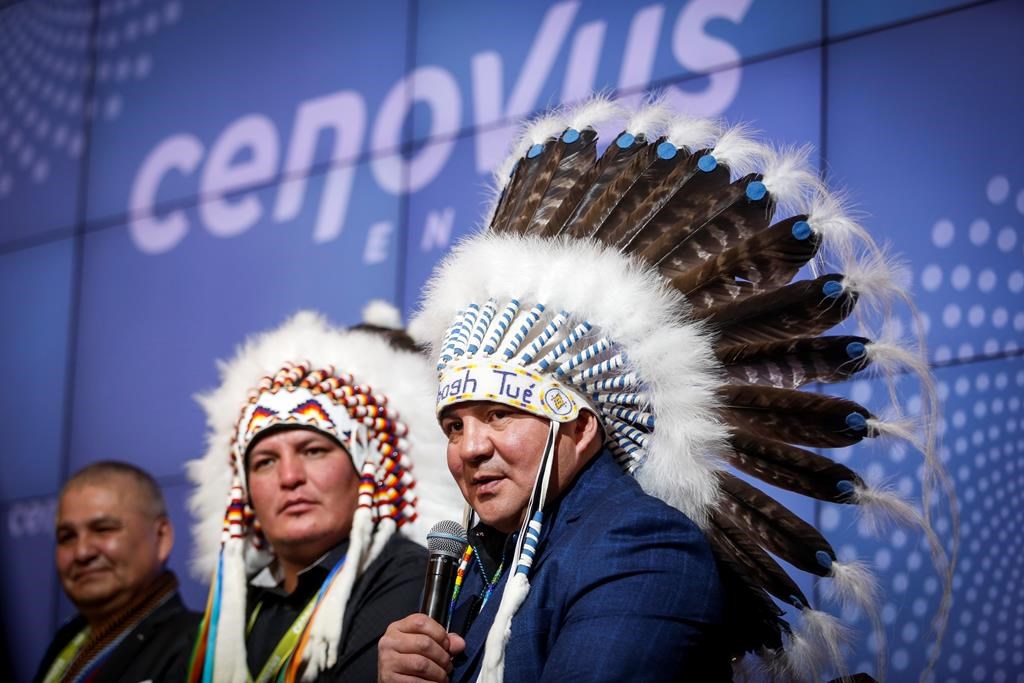EDITOR’S NOTE: A previous version of this story said Alberta’s Energy minister is responsible for issuing carbon storage permits and in charge of reviewing such plans. In fact, that authority has been delegated to the Alberta Energy Regulator.

Seven Alberta First Nations have banded together to seek answers as industry and government move on billion-dollar plans to inject and store millions of tonnes of greenhouse gases underneath or adjacent to their traditional lands.
“We don’t know how pumping carbon underground will affect our lakes, our rivers — even our underground reservoirs,” said councillor Michael Lameman of Beaver Lake Cree Nation, one of the members of the Treaty 6 working group.
“(Industry’s) been vague, not very forthcoming.”
The working group includes Heart Lake First Nation, Beaver Lake Cree Nation, Whitefish Lake First Nation, Kehewin Cree Nation, Frog Lake First Nation, Cold Lake First Nations and Onion Lake Cree Nation. Saddle Lake Cree Nation is observing the group.
“There’s lots to be checked as far as the project relates to both the safety of the environment and the communities,” said Darryl Steinhauer, consultation co-ordinator for Whitefish Lake.
“The (carbon capture) project is inclusive of eight Nations where people are not only practising their treaty rights but living there day to day. Safety is a big concern.”
Industry says it’s doing its best.
- Calgary taxi driver hailed as hero after baby born in back seat
- Another ‘catastrophic’ water main break prompts usage limits for Calgary region
- Environment Minister Rebecca Schulz quits cabinet, to leave soon as Alberta MLA
- Attempted kidnapping near Banff Christmas Market prompts police investigation
“We are in the early stages of consultation with communities,” said a statement from Kendall Dilling, head of Pathways Alliance, which represents 95 per cent of Alberta’s oilsands production. “We are dedicated to working together with Treaty 6 First Nations and ongoing discussions will take place in a confidential manner.”
A Pathways spokeswoman said the first project-related applications are expected by the end of next month.
“Focusing initially on the proposed right-of-way for the CO2 transportation network, Pathways now intends to target filing applications under the Public Lands Act in (the first quarter),” Jerrica Goodwin said in an email.

Get breaking National news
Indigenous communities, who watch the promotional TV ads and hear the support from politicians, say they feel the momentum building.
“We’re hearing a lot of concerns,” said Steinhauer. “(Councillors) are getting called in the evening about it, saying ‘Hey, what’s going on?’ ”
The bands would like to know.
“The Pathways Alliance has not provided our First Nations with any reports or data assessing the potential risks associated with the storage of carbon adjacent to and beneath our reserve lands,” says an Oct. 13 letter from the First Nations to Pathways.
Pathways Alliance is proposing a gargantuan scheme to capture carbon dioxide from 13 oilsands facilities, pipe it hundreds of kilometres south and pump it from at least 16 injection wells to more than a kilometre underground. There, porous limestone underneath a layer of solid rock salt is to hold it fast.
The first phase is budgeted at $16.5 billion and will stash up to 12 million tonnes of carbon a year by 2030. Depending on who’s measuring, that’s between 12 and 17 per cent of the oilsands’ annual emissions.
Advocates say projects such as the Boundary Dam power plant in Saskatchewan and Shell’s Quest project outside Edmonton prove carbon capture and storage can work. Quest injects about a million tonnes of carbon dioxide underground annually.
Others say leakage — especially through poorly sealed oil and gas wells or into groundwater — remains a concern.
Alberta’s underground carbon tank is vast. A Pathways map suggests its proposed storage hub covers thousands of square kilometres of northeastern Alberta.
That map does not show any reserve lands or First Nations communities, although there are 11 such areas within or adjacent to it.
“The map of the proposed sequestration hub … is premised on the notion that our First Nations and our reserve lands either do not exist or we simply don’t matter,” says the letter from the First Nations.
The approval process for the project also raises concerns.
Renato Gandia, spokesman for the Alberta Energy Regulator, said the agency reviews facilities that capture carbon, pipelines that transport it and wells that inject it. It has also been delegated responsibility for reviewing risk assessment, monitoring and cleanup plans for carbon storage.
“A carbon sequestration tenure or agreement from the government of Alberta is required if a company wants to apply for a CCS project,” Gandia wrote in an email.
Applications under the Carbon Sequestration Tenure Regulations require risk assessment, monitoring and cleanup plans. Those regulations do not mention avenues for public input, although such projects will come under the regulator’s established review processes.
“It appears that the regulatory regime is going to consist of a series of isolated, low-level regulatory applications,” said Clayton Leonard, lawyer for several of the First Nations in the working group.
Pore space under reserve lands is owned by First Nations. Leonard said it’s unlikely that carbon dioxide injected into Crown land can be kept from seeping under reserves.
“I don’t think you can talk about pore space with that neat boundary to it.”
Leonard said information gleaned from public meetings held in non-reserve communities suggests injection wells will be located close to reserves.
“That really raises our level of concern.”
Meanwhile, Steinhauer said he continues to face questions from band members every day.
“Grocery shopping isn’t as quick any more as it used to be.”






Comments